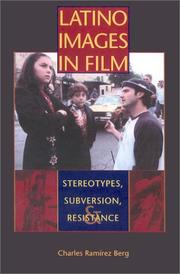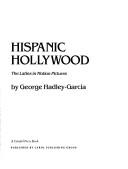| Listing 1 - 4 of 4 |
Sort by
|

ISBN: 9780292709072 9780292709065 0292709072 0292709064 Year: 2002 Publisher: Austin, Tex. University of Texas Press
Abstract | Keywords | Export | Availability | Bookmark
 Loading...
Loading...Choose an application
- Reference Manager
- EndNote
- RefWorks (Direct export to RefWorks)
The bandido, the harlot, the male buffoon, the female clown, the Latin lover, and the dark lady—these have been the defining, and demeaning, images of Latinos in U.S. cinema for more than a century. In this book, Charles Ramírez Berg develops an innovative theory of stereotyping that accounts for the persistence of such images in U.S. popular culture. He also explores how Latino actors and filmmakers have actively subverted and resisted such stereotyping. In the first part of the book, Berg sets forth his theory of stereotyping, defines the classic stereotypes, and investigates how actors such as Raúl Julia, Rosie Pérez, José Ferrer, Lupe Vélez, and Gilbert Roland have subverted stereotypical roles. In the second part, he analyzes Hollywood's portrayal of Latinos in three genres: social problem films, John Ford westerns, and science fiction films. In the concluding section, Berg looks at Latino self-representation and anti-stereotyping in Mexican American border documentaries and in the feature films of Robert Rodríguez. He also presents an exclusive interview in which Rodríguez talks about his entire career, from Bedhead to Spy Kids, and comments on the role of a Latino filmmaker in Hollywood and how he tries to subvert the system.

ISBN: 0292709064 0292709072 0292798229 0292783000 9780292709072 9780292709065 Year: 2002 Publisher: Austin: University of Texas press,
Abstract | Keywords | Export | Availability | Bookmark
 Loading...
Loading...Choose an application
- Reference Manager
- EndNote
- RefWorks (Direct export to RefWorks)
The bandido, the harlot, the male buffoon, the female clown, the Latin lover, and the dark lady—these have been the defining, and demeaning, images of Latinos in U.S. cinema for more than a century. In this book, Charles Ramírez Berg develops an innovative theory of stereotyping that accounts for the persistence of such images in U.S. popular culture. He also explores how Latino actors and filmmakers have actively subverted and resisted such stereotyping. In the first part of the book, Berg sets forth his theory of stereotyping, defines the classic stereotypes, and investigates how actors such as Raúl Julia, Rosie Pérez, José Ferrer, Lupe Vélez, and Gilbert Roland have subverted stereotypical roles. In the second part, he analyzes Hollywood's portrayal of Latinos in three genres: social problem films, John Ford westerns, and science fiction films. In the concluding section, Berg looks at Latino self-representation and anti-stereotyping in Mexican American border documentaries and in the feature films of Robert Rodríguez. He also presents an exclusive interview in which Rodríguez talks about his entire career, from Bedhead to Spy Kids, and comments on the role of a Latino filmmaker in Hollywood and how he tries to subvert the system.

ISBN: 0806511850 0806512083 Year: 1993 Publisher: New York : Carol Pub. Group,
Abstract | Keywords | Export | Availability | Bookmark
 Loading...
Loading...Choose an application
- Reference Manager
- EndNote
- RefWorks (Direct export to RefWorks)
Hispanic American motion picture actors and actresses. --- Hispanic Americans in motion pictures --- Latin Americans in motion pictures. --- Motion pictures --- Acteurs de cinéma américains d'origine latino-américaine --- Américains d'origine latino-américaine au cinéma --- Latino-Américains au cinéma --- Cinéma --- History. --- Histoire --- Hispanic Americans in motion pictures. --- Acteurs de cinéma américains d'origine latino-américaine --- Américains d'origine latino-américaine au cinéma --- Latino-Américains au cinéma --- Cinéma
Book
ISBN: 1283369958 9786613369956 0813550254 9780813550251 9780813548807 0813548802 9780813548814 0813548810 Year: 2011 Publisher: New Brunswick, N.J. : Rutgers University Press,
Abstract | Keywords | Export | Availability | Bookmark
 Loading...
Loading...Choose an application
- Reference Manager
- EndNote
- RefWorks (Direct export to RefWorks)
Dance and the Hollywood Latina asks why every Latina star in Hollywood history, from Dolores Del Rio in the 1920's to Jennifer Lopez in the 2000's, began as a dancer or danced onscreen. While cinematic depictions of women and minorities have seemingly improved, a century of representing brown women as natural dancers has popularized the notion that Latinas are inherently passionate and promiscuous. Yet some Latina actresses became stars by embracing and manipulating these stereotypical fantasies. Introducing the concepts of "inbetween-ness" and "racial mobility" to further illuminate how racialized sexuality and the dancing female body operate in film, Priscilla Peña Ovalle focuses on the careers of Dolores Del Rio, Rita Hayworth, Carmen Miranda, Rita Moreno, and Jennifer Lopez. Dance and the Hollywood Latina helps readers better understand how the United States grapples with race, gender, and sexuality through dancing bodies on screen.
Sex in motion pictures. --- Race in motion pictures. --- Dance in motion pictures, television, etc. --- Hispanic American motion picture actors and actresses. --- Hispanic Americans in the motion picture industry. --- Hispanic Americans in motion pictures. --- Sex in moving-pictures --- Motion pictures --- Erotic films --- Pornographic films --- Dance in television --- Dance on television --- Dancing in motion pictures, television, etc. --- Dancing in moving-pictures, television, etc. --- Television --- Motion picture actors and actresses, Hispanic American --- Motion picture actors and actresses --- Motion picture industry --- Sociology of minorities --- Sociology of the family. Sociology of sexuality --- Film --- United States --- United States of America
| Listing 1 - 4 of 4 |
Sort by
|

 Search
Search Feedback
Feedback About UniCat
About UniCat  Help
Help News
News